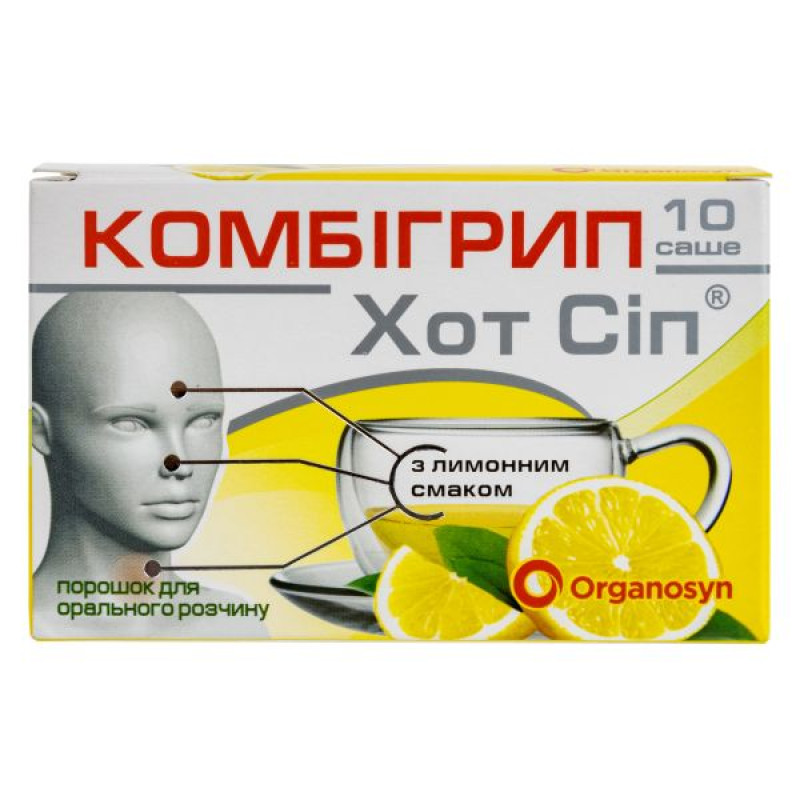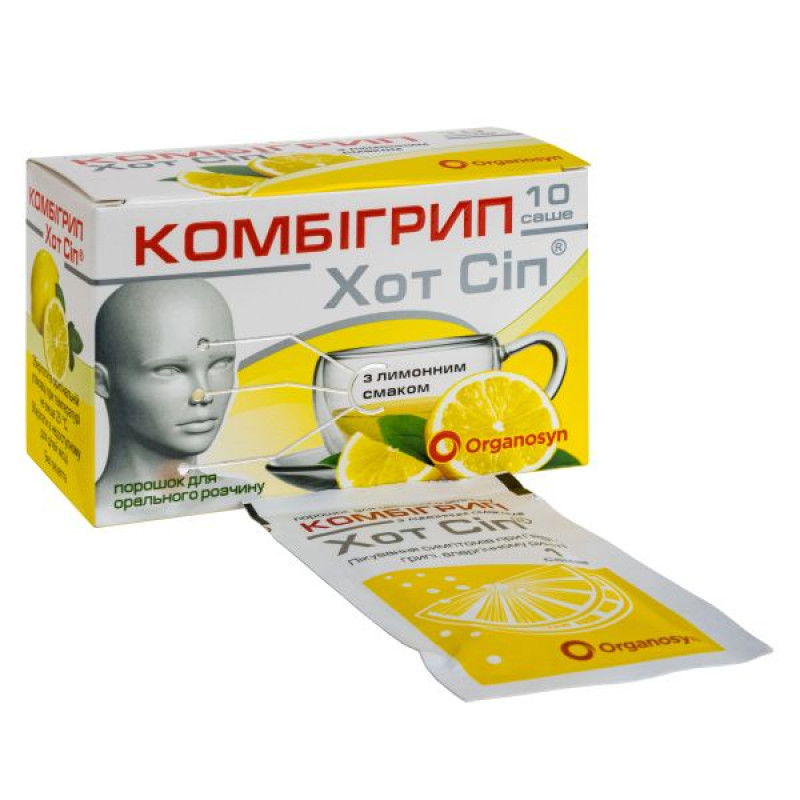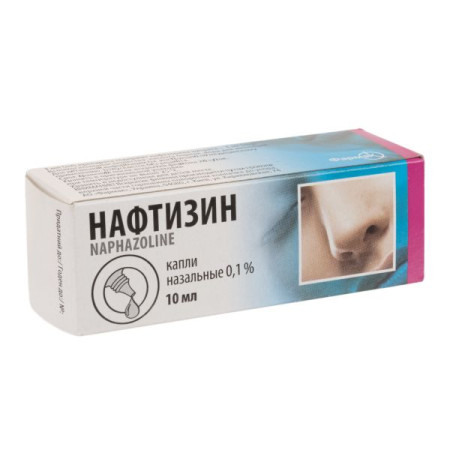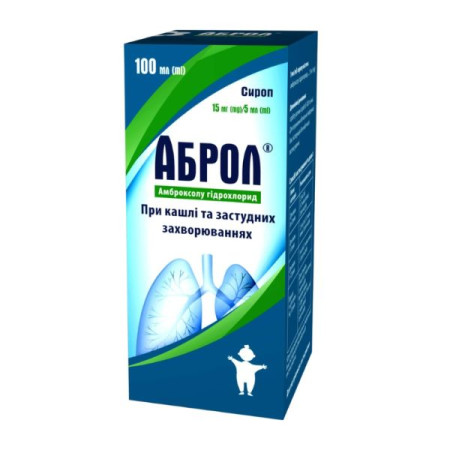Combigrip Hot Sip powder for oral solution sachet 5 g lemon No. 10
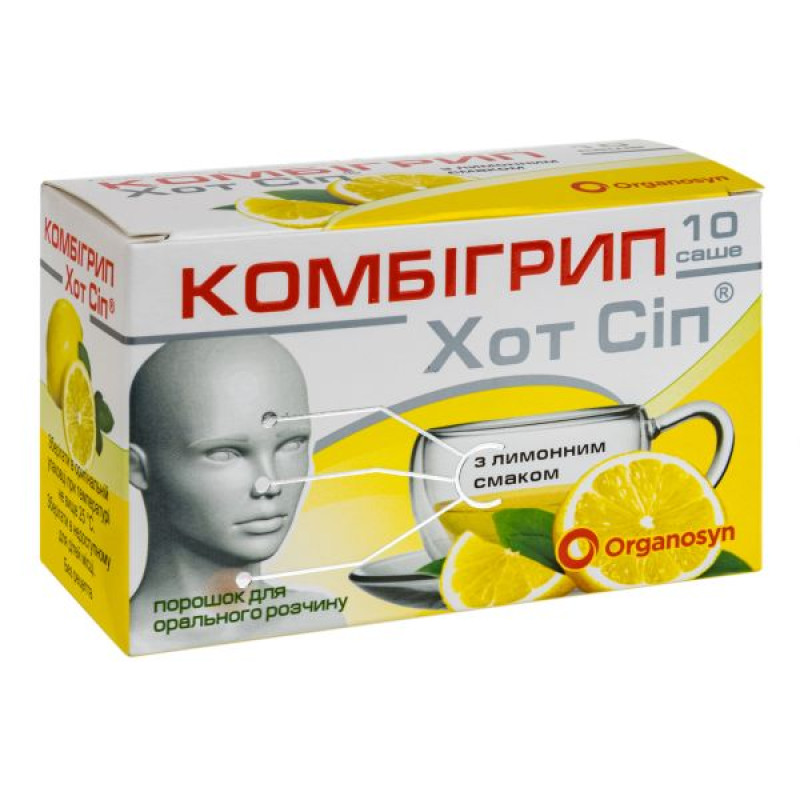
Instructions for use Combigrip Hot Sip powder for oral solution sachet 5 g lemon No. 10
Composition
active ingredients: paracetamol, cetirizine hydrochloride, phenylephrine hydrochloride;
1 sachet of 5 g contains paracetamol 500 mg, cetirizine hydrochloride 10 mg, phenylephrine hydrochloride 10 mg;
excipients:
Kombigrip Hot Sip with lemon flavor: colloidal anhydrous silicon dioxide, aspartame (E 951), mannitol (E 421), xanthan gum, tartrazine (E 102), lemon flavoring, sucrose;
Kombigrip Hot Sip with raspberry flavor: colloidal anhydrous silicon dioxide, aspartame (E 951), mannitol (E 421), xanthan gum, erythrosine (E 127), raspberry flavoring, sucrose.
Dosage form
Powder for oral solution.
Main physicochemical properties:
Kombigrip Hot Sip with lemon flavor: almost white powder with a pale yellow tint.
Combigrip Hot Sip with raspberry flavor: almost white powder with a pale pink tint.
Pharmacotherapeutic group
Analgesics and antipyretics. Paracetamol, combinations without psycholeptics.
ATX code N02B E51.
Pharmacological properties
Pharmacodynamics
Paracetamol has analgesic, antipyretic and weak anti-inflammatory effects.
The mechanism of action of paracetamol is associated with the drug's effect on the thermoregulation center in the hypothalamus, its ability to inhibit the synthesis of prostaglandins and inflammatory mediators (kinin, serotonin), and an increase in the pain threshold.
Cetirizine hydrochloride is a potent antihistamine, a selective H1-receptor antagonist. It inhibits the histamine-mediated early phase of the allergic reaction, and also reduces eosinophil migration and the release of inflammatory mediators, thereby weakening the late allergic reaction. Cetirizine has practically no effect on other receptors and therefore does not cause undesirable anticholinergic and antiserotonin effects.
Phenylephrine hydrochloride is a relatively selective α1-adrenomimetic. It has a weak effect on α2- and β-adrenergic receptors. Due to its vasoconstrictor effect, phenylephrine reduces swelling of the nasal mucosa, the volume of nasal secretions and improves nasal breathing, as it facilitates the passage of air through the nose. It is used to temporarily relieve nasal congestion in colds, acute respiratory viral infections, hay fever and other allergic reactions.
Pharmacokinetics
Paracetamol is rapidly absorbed from the gastrointestinal tract, peak plasma concentrations are reached within 10-60 minutes. It is distributed to most body tissues. At normal therapeutic concentrations, only a small portion of paracetamol binds to plasma proteins. The plasma half-life is 1-3 hours. Paracetamol is metabolized primarily in the liver and excreted by the kidneys, primarily as glucuronide and sulfate conjugates; less than 5% of the dose is excreted unchanged.
Cetirizine hydrochloride is rapidly absorbed from the gastrointestinal tract; when taken with food, absorption is not reduced, but may be slightly delayed. The maximum concentration in blood plasma (approximately 0.3 μg/ml) is reached 30-60 minutes after taking 10 mg of cetirizine. The terminal half-life in adults is 6.7-10.7 hours, and in children - 6.1-7.1 hours. Cetirizine is excreted mainly unchanged in the urine. In patients with mild or moderate renal impairment, the half-life increases to 19-21 hours. Approximately 90% of cetirizine binds to plasma proteins.
Phenylephrine hydrochloride is readily absorbed after oral administration, but due to extensive first-pass metabolism, mainly in enterocytes, systemic bioavailability is only 40%. Peak plasma concentrations are reached 1-2 hours after administration. The plasma half-life is 2-3 hours. After absorption, phenylephrine is extensively biotransformed in the liver and excreted in the urine, mainly as metabolites; less than 20% of the dose is excreted unchanged.
Indication
Treatment of symptoms that occur during acute respiratory viral infections, influenza, allergic rhinitis (increased body temperature, runny nose, swelling of the nasal mucosa, body aches, headache).
Contraindication
Hypersensitivity to the active substances, hydroxyzine, any piperazine derivatives in history or to other components of the drug; severe liver and kidney dysfunction; congenital hyperbilirubinemia; Gilbert's syndrome; glucose-6-phosphate dehydrogenase deficiency; alcoholism; blood diseases (including severe anemia, leukopenia); arterial hypertension; cardiovascular diseases; hyperthyroidism; diabetes mellitus; angle-closure glaucoma; prostatic hypertrophy; pheochromocytoma; use in patients treated with monoamine oxidase inhibitors and within 2 weeks after discontinuation of such therapy.
Interaction with other medicinal products and other types of interactions
Paracetamol
Coumarin anticoagulants (e.g. warfarin): increased anticoagulant effect with long-term regular daily use of paracetamol. This increases the risk of bleeding. Periodic administration does not show a significant effect.
Drugs that stimulate the activity of liver microsomal enzymes (e.g. barbiturates, monoamine oxidase inhibitors, tricyclic antidepressants, anticonvulsants), hepatotoxic drugs: increased hepatotoxicity of paracetamol.
Isoniazid: increased risk of hepatotoxic syndrome (when using high doses of paracetamol).
Barbiturates: reduction of the antipyretic effect of paracetamol.
The rate of absorption of paracetamol may be increased by metoclopramide and domperidone and decreased by cholestyramine.
Caution should be exercised when using paracetamol with flucloxacillin, as concomitant administration is associated with high anion gap metabolic acidosis, especially in patients with risk factors (see section "Special warnings and precautions for use").
The drug should not be used simultaneously with alcohol.
Cetirizine hydrochloride
Theophylline: In a multiple-dose study of theophylline (400 mg once daily) and cetirizine, a slight (16%) decrease in cetirizine clearance was observed, while the disposition of theophylline was not affected by concomitant administration of cetirizine.
Ritonavir: In a multiple dose study of ritonavir (600 mg twice daily) and cetirizine (10 mg daily), the duration of exposure to cetirizine was increased by approximately 40%, while ritonavir disposition was slightly impaired (-11%) when co-administered with cetirizine.
Sedatives: There is no evidence of an increase in the effect of sedatives when used in therapeutic doses. However, concomitant use of these agents should be avoided.
Pharmacokinetic interaction studies have been conducted with cetirizine and pseudoephedrine, cimetidine, ketoconazole, erythromycin, azithromycin; no pharmacokinetic interactions were observed.
Studies of cetirizine with cimetidine, glipizide, diazepam, and pseudoephedrine have not revealed evidence of adverse pharmacodynamic interactions.
Studies of cetirizine with azithromycin, erythromycin, ketoconazole, theophylline, and pseudoephedrine have revealed no evidence of adverse clinical interactions. In addition, concomitant use of cetirizine with macrolides or ketoconazole has never resulted in clinically significant ECG changes.
The extent of absorption of cetirizine is not reduced by food intake, although the absorption rate is reduced by 1 hour.
No clinically significant interactions with alcohol have been observed when cetirizine is taken at therapeutic doses (at blood alcohol levels of 0.5 g/l). However, the drug should not be used simultaneously with alcohol.
Phenylephrine hydrochloride.
Monoamine oxidase inhibitors: potentiation of the cardiac and hypertensive effects of phenylephrine. The drug should not be used in patients treated with monoamine oxidase inhibitors and within 2 weeks after discontinuation of such therapy.
Sympathomimetic amines: increased risk of cardiovascular adverse reactions.
Antihypertensive agents (e.g. β-blockers, debrisoquine, guanethidine, reserpine, methyldopa): Reduced efficacy of β-blockers and other antihypertensive agents. Increased risk of hypertension and other cardiovascular adverse reactions.
Tricyclic antidepressants (e.g. amitriptyline): increased risk of cardiovascular adverse reactions.
Cardiac glycosides (e.g. digoxin): increased risk of heart rhythm disturbances or myocardial infarction.
Application features
Do not exceed the indicated doses of the drug.
Do not use the drug simultaneously with other products containing paracetamol.
If symptoms persist or the headache becomes persistent, the patient should consult a doctor.
Patients who take daily analgesics for mild arthritis should consult a doctor before using the drug.
Before using the drug, you should consult a doctor if you have liver or kidney diseases, or if you are taking anticoagulants.
Patients with alcoholic non-cirrhotic liver disease are at increased risk of hepatotoxic effects of paracetamol.
In patients with severe infections such as sepsis, which are accompanied by a decrease in glutathione levels, the risk of metabolic acidosis may be increased when taking paracetamol. Symptoms of metabolic acidosis include deep, rapid or difficult breathing, nausea, vomiting, loss of appetite. You should consult a doctor immediately if these symptoms occur.
Caution is advised when using paracetamol with flucloxacillin due to the increased risk of high anion gap metabolic acidosis, especially in patients with severe renal insufficiency, sepsis, malnutrition and other causes of glutathione deficiency (e.g. chronic alcoholism), and when maximum daily doses of paracetamol are used. Close monitoring of patients, including measurement of urinary 5-oxoproline, is recommended.
Antihistamines suppress the skin allergy test, so before conducting it, taking the drug must be stopped 3 days before the test.
The drug may affect the results of laboratory tests for blood glucose and uric acid.
The drug contains aspartame (a source of phenylalanine), which may be harmful for patients with phenylketonuria.
Use during pregnancy or breastfeeding
The drug should not be used during pregnancy and breastfeeding.
Ability to influence reaction speed when driving vehicles or other mechanisms
Patients who drive vehicles or operate machinery should not exceed recommended doses and should take into account their own body's response to the drug.
Method of administration and doses
The contents of 1 sachet should be dissolved in a glass of hot water (but not boiling water) and drunk.
Adults and children over 12 years of age should take 1 sachet every 4-6 hours (as needed to relieve symptoms) up to 4 times a day. The intervals between doses should be at least 4 hours. A single dose should not exceed 1 sachet. The duration of treatment is no more than 7 days.
Children
The drug should be used in children over 12 years of age.
Overdose
Symptoms of paracetamol overdose.
Liver damage may occur in adults who have taken 10 g or more of paracetamol and in children who have taken more than 150 mg/kg of body weight. In patients with risk factors (long-term use of carbamazepine, phenobarbital, phenytoin, primidone, rifampicin, St. John's wort or other drugs that induce liver enzymes; alcohol abuse; insufficiency of the glutathione system, such as malnutrition, cystic fibrosis, AIDS, starvation, cystic fibrosis, cachexia), taking 5 g or more of paracetamol may lead to liver damage.
Symptoms of overdose in the first 24 hours: pallor, nausea, vomiting, anorexia and abdominal pain. Liver damage may become apparent 12-48 hours after overdose. Glucose metabolism disorders and metabolic acidosis may occur. In severe poisoning, liver failure may progress to encephalopathy, hemorrhage, hypoglycemia, coma and be fatal. Acute renal failure with acute tubular necrosis may present with severe lumbar pain, hematuria, proteinuria and may develop even in the absence of severe liver damage. Cardiac arrhythmia and pancreatitis have also been reported.
Symptoms of cetirizine hydrochloride overdose.
Symptoms observed after significant overdose of cetirizine are mainly related to effects on the central nervous system or to effects that may indicate anticholinergic activity. Side effects reported after doses exceeding at least 5 times the recommended daily dose include: confusion, diarrhea, dizziness, fatigue, headache, malaise, mydriasis, pruritus, restlessness, sedation, drowsiness, stupor, tachycardia, tremor, urinary retention.
Symptoms of phenylephrine hydrochloride overdose.
Overdose with phenylephrine can lead to: arterial hypertension with reflex bradycardia, nervousness, headache, dizziness, insomnia, nausea, vomiting, tachycardia, palpitations, allergic reactions, mydriasis, acute attack of angle-closure glaucoma (mainly in the presence of angle-closure glaucoma), dysuria and urinary retention (mainly in the presence of bladder obstruction). In severe cases, confusion, hallucinations, convulsions and arrhythmias may occur. However, in case of overdose of the combined drug, a toxic dose of paracetamol will be reached much earlier than the toxic effects of phenylephrine appear.
Treatment.
The patient should be taken to hospital immediately, even if there are no early symptoms of overdose. Symptoms may be limited to nausea and vomiting or may not reflect the severity of the overdose or the risk of organ damage.
Treatment includes symptomatic and supportive measures. If the overdose has been taken within 1 hour, gastric lavage and activated charcoal are indicated. The concentration of paracetamol in the blood plasma should be measured 4 hours or later after ingestion (earlier concentrations are unreliable). Treatment with N-acetylcysteine can be used within 24 hours of ingestion, but the maximum protective effect occurs when it is used within 8 hours after ingestion. The effectiveness of the paracetamol antidote decreases sharply after this time. If necessary, the patient should be given N-acetylcysteine intravenously, according to the established dose list. In the absence of vomiting, oral methionine can be used as a suitable alternative in remote areas outside the hospital.
Adverse reactions
From the blood and lymphatic system: thrombocytopenia, agranulocytosis, anemia, sulfhemoglobinemia and methemoglobinemia (cyanosis, shortness of breath, heart pain), hemolytic anemia, bruising or bleeding.
From the nervous system: headache, dizziness, paresthesia, convulsions, dysgeusia, dyskinesia, dystonia, fainting, tremor, amnesia, memory impairment.
From the organs of hearing and balance: vertigo.
From the cardiovascular system: tachycardia, palpitations, cardiac arrhythmias, arterial hypertension.
On the part of the respiratory system: bronchospasm in patients sensitive to acetylsalicylic acid and other NSAIDs, pharyngitis.
On the part of the digestive tract: abdominal pain, dry mouth, nausea, diarrhea, epigastric pain, vomiting.
Renal and urinary disorders: dysuria, enuresis, urinary retention.
On the part of the endocrine system: hypoglycemia, up to hypoglycemic coma.
Nutritional and metabolic disorders: increased appetite.
On the part of the hepatobiliary system: impaired liver function (increased levels of bilirubin and liver enzymes: transaminases, alkaline phosphatase, γ-glutamyltransferase), usually without the development of jaundice.
Immune system, skin and subcutaneous tissue disorders: hypersensitivity reactions, including anaphylaxis, anaphylactic shock, pruritus, skin and mucous membrane rash (including erythematous and generalized rash), urticaria, angioedema, local drug eruptions, erythema multiforme exudative (including Stevens-Johnson syndrome), toxic epidermal necrolysis (Lyell's syndrome). edema.
On the part of the psyche: drowsiness, anxiety, aggressiveness, confusion, depression, hallucinations, insomnia, tics, suicidal thoughts.
General disorders: fatigue, asthenia, malaise, edema.
Examination: weight gain.
Expiration date
4 years.
Storage conditions
Store in the original packaging at a temperature not exceeding 25 ° C. Keep out of the reach of children.
Packaging
5 g of powder in a sachet, 10 sachets in a cardboard pack.
Vacation category
Without a prescription.
Producer
Evertogen Life Sciences Limited.
Location of the manufacturer and its business address
Plot No: S-8, S-9, S-13/P & S-14/P TSIIC, Pharma SEZ, Green Industrial Park, Polepally (V), Jadcherla (M), Mahabubnagar, Telangana, IN-509 301, India
There are no reviews for this product.
There are no reviews for this product, be the first to leave your review.
No questions about this product, be the first and ask your question.







